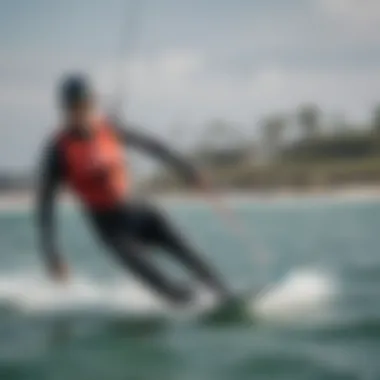The Essential Guide to 5mm Wetsuits for Kiteboarding


Intro
Kiteboarding, with its exhilarating blend of wind and water, demands not just skill but also the right gear. For those who want to ride the waves without feeling like they’ve jumped into a freezer, a 5mm wetsuit becomes almost like a second skin. This thickness offers an ideal balance, keeping body heat from slipping away in cooler waters while still providing enough flexibility for dynamic movements. This article will take a comprehensive look at the 5mm wetsuit’s role in kiteboarding, analyzing different materials, advantages, and considerations that kiteboarders should keep in mind.
The suitability of a wetsuit can make or break a session out on the water. Picture yourself zipping up a wetsuit before a ride, feeling the snug fit hug your body. It’s not just a piece of gear; it’s your armor against the elements, allowing you to focus entirely on your technique and the joy of riding the wind.
Gear Insights
The right gear can elevate your kiteboarding experience significantly. With dozens of options available, knowing the nuances in wetsuits can help you make a smart choice.
Latest Gear Reviews
Modern wetsuits come packed with advancements. For instance, brands like O’Neill and Rip Curl have introduced innovative thermal linings that enhance insulation without adding bulk. Reviews for the O’Neill Hyperfreak, known for its lightweight core and flexibility, consistently praise its performance in cold waters. Remind yourself, different brands offer distinct fits and styles, which means it’s best to try a few out before committing.
Essential Gear for Beginners
Starting off in kiteboarding requires more than just enthusiasm; beginner kiteboarders should equip themselves appropriately.
- 5mm Wetsuit: Essential for comfort in cooler waters, enhancing control while you learn.
- Harness: A waist or seat harness allows for proper support and reduces strain on the lower back.
- Board and Kite: Choose equipment that suits your weight and skill level, as this can greatly affect your learning curve.
- Safety Gear: Don’t forget impact vests and helmets, especially for those who are just starting.
By investing wisely in this gear, you set yourself up for success, improving both your safety and enjoyment on the water.
Techniques and Tips
Once you've sorted your gear, mastering techniques and strategies is vital for any kiteboarder.
Advanced Tricks and Techniques
As kiteboarding skills develop, so does the repertoire of tricks. From jumps to rotations, the right wetsuit can sometimes enhance your performance—its fit allows for greater mobility, which is necessary for executing those big air maneuvers. Being comfortable is often half the battle won.
Safety Practices for Kiteboarders
The thrill of kiteboarding shouldn’t overshadow safety considerations. Here are crucial practices:
- Know the Weather: Always check conditions before heading out.
- Understand Your Limits: Don’t attempt tricks beyond your skill level.
- Buddy System: Whenever possible, kite with a friend.
"The water doesn’t care how good you are; it only knows the conditions and your own safety practices."
In the end, kiteboarding is about balance—between adventure and safety, freedom and control. A 5mm wetsuit is a key player in this equation, providing the comfort needed to focus on the thrills of the sport.
Prologue to Wetsuits in Kiteboarding
Kiteboarding, with its exhilarating mix of wind, water, and skill, is a sport that attracts adventurers from all walks of life. Central to a kiteboarder's experience is the wetsuit, particularly the 5mm variety. This thickness is often the go-to choice for many riders. The role it plays cannot be understated—it’s not just about warmth; it's about enhancing performance and ensuring safety in various water conditions.
When we think about kiteboarding, we often picture soaring through the waves. But let’s not forget the elements at play. The water temperature can make or break a session. A wetsuit, especially one that is 5mm thick, provides an essential barrier against cold water. Just to illustrate, consider that a sudden drop in temperature can sap energy, diverting focus from the sport to discomfort. This is precisely where the significance of a suitable wetsuit comes into play.
Beyond just warmth, a well-fitted wetsuit contributes to mobility. Kiteboarding requires a full range of motion, and the design of a 5mm wetsuit allows for adequate flexibility while still offering insulation. In this article, we will delve into the anatomy, benefits, selection criteria, and care for the wetsuit to equip both beginners and seasoned riders with the knowledge they need.
A good wetsuit isn’t merely an accessory—it’s an investment in your comfort and your performance on the water.
With that in mind, let’s first define what wetsuits are and break down their essential role in the kiteboarding world.
The Anatomy of a 5mm Wetsuit


Understanding the anatomy of a 5mm wetsuit is essential for anyone looking to enhance their kiteboarding experience. A wetsuit serves as more than just a piece of gear; it plays a vital role in safeguarding the body against the elements while still allowing for the freedom of movement crucial in kiteboarding. The components that make up a 5mm wetsuit contribute significantly to warmth, flexibility, and overall performance in water sports.
Materials Used in 5mm Wetsuits
A widespread misconception is that all wetsuits are made of the same material. However, the construction of a 5mm wetsuit typically involves a combination of high-quality neoprene, a synthetic rubber that provides excellent insulation. Neoprene is favored for its ability to retain heat while allowing for flexibility.
In addition to neoprene, some wetsuits incorporate a lining made from various thermal materials. These linings can include fleece or other insulating layer, which trap warmth close to the skin and further aid in preventing heat loss. The thickness of the wetsuit, measured at 5mm, is specifically designed to offer optimal insulation in cold water conditions, making it ideal for kiteboarding during cooler months or in colder regions.
Another notable material often found in wetsuits is nylon, which is used for the outer layer. This not only adds durability but also provides resistance to abrasions and tears that can happen during water sports. Therefore, when choosing a wetsuit, one must pay careful attention to the materials used, as they can significantly impact comfort and performance.
Construction and Design Features
The construction of a 5mm wetsuit is as crucial as the materials themselves. A well-designed wetsuit includes features that ensure a snug fit while allowing for movement. Let's break down some key aspects:
- Stitching Techniques: Quality stitching is essential in wetsuit construction. Flatlock stitching or glued and blind-stitched seams help to minimize water entry while ensuring flexibility. A suit that leaks can make for an uncomfortable ride in chilly water.
- Seal and Zip Design: Many 5mm wetsuits come with various types of seals around the wrists and ankles to reduce water flush and increase thermal retention. Additionally, zipper designs—either back zip or chest zip—are critical for function and ease of use. A chest zip may provide a more streamlined profile but can be more challenging to get into compared to a back zip.
- Ergonomic Cut: The cut of the wetsuit is a crucial aspect that affects mobility. Designs that follow the natural contours of the body allow for unrestricted movement. This is particularly important for kiteboarders who need to maintain a wide range of motion when jumping or making quick directional changes.
Understanding these design features not only aids in choosing the right wetsuit but also enhances your kiteboarding experience. By investing time in comprehending what makes a 5mm wetsuit effective, kiteboarders can ensure both comfort and performance in a wide array of conditions.
Benefits of a 5mm Wetsuit
The significance of a 5mm wetsuit in the world of kiteboarding is substantial. Not only does it provide essential insulation and comfort, but it also supports the performance of kiteboarders across various weather conditions. In a sport where the balance between exhilaration and risk can be a fine line to walk, choosing the right wetsuit could be the difference between a pleasant day on the water and a cold, regrettable outing. The dual elements of thermal insulation and flexibility are crucial topics worth exploring.
Thermal Insulation Properties
When it comes to thermal insulation, a 5mm wetsuit truly excels in maintaining body heat. The thickness of the neoprene material offers an effective barrier against chilly waters, ensuring that you remain warm even when the conditions are less than ideal. This is particularly important for kiteboarders who tend to be out for extended periods, frequently exposing themselves to wind chill and fluctuating temperatures.
Key Thermal Insulation Features:
- Neoprene Thickness: The 5mm thickness traps warmth while allowing for some breathability, which is vital during intense activity.
- Sealed Seams: Look for wetsuits with glued and blind-stitched seams. These features enhance insulation by minimizing water entry, keeping you warmer.
- Paddle-Friendly Design: Many 5mm wetsuits incorporate flexible designs that allow for ease of movement, ensuring your thermal advantage doesn’t come at the cost of comfort.
"A reliable wetsuit is more than just a piece of gear; it’s your first line of defense against the cold elements that can sap your energy and focus."
When kiteboarding in cooler waters, the thermal insulation properties of a 5mm wetsuit promote not only comfort but also safety. Maintaining a stable core temperature helps prevent fatigue and enhances your focus, which ultimately contributes to better performance on the water.
Flexibility and Movement
While thermal insulation is vital, flexibility is equally important for kiteboarders. A 5mm wetsuit strikes a remarkable balance between keeping you warm and allowing for the necessary mobility. The design of modern wetsuits takes into account the movements inherent in kiteboarding, ensuring that gear not only fits snugly but also accommodates dynamic actions like jumping, twisting, and rapid maneuvers.
Attributes of Flexibility in a 5mm Wetsuit:
- Super Stretch Neoprene: Many brands now use advanced stretchable materials that enhance your range of motion without sacrificing warmth.
- Anatomical Cuts: Wetsuits designed with body contours in mind are more comfortable. They prevent bunching or restriction, which otherwise could hinder your performance.
- Reinforced Areas: Areas that typically endure more strain, like shoulders and knees, can feature specialized reinforcement so that the suit can take more abuse without losing its form.
A key consideration for any kiteboarder is how well the wetsuit allows for full movement. The ability to execute intricate tricks without the feeling of being constrained makes all the difference in enjoying your time on the water.
In summary, the benefits of investing in a 5mm wetsuit are manifold. From effective thermal insulation that wards off chill, to superior flexibility that allows for athletic prowess, it's a necessary component of any kiteboarder's kit.
Engaging with the ocean in cooler temperatures can truly elevate your kiteboarding experience when equipped with the right wetsuit. Your comfort and performance are directly linked to this crucial choice.
Choosing the Right Wetsuit Thickness
When diving into the world of kiteboarding, selecting the right wetsuit thickness feels like picking the right tool for a craftsman. Each component plays its part, but the thickness of the wetsuit is absolutely crucial for ensuring comfort and performance. Whether you’re a seasoned pro or just dipping your toes into this exhilaration, understanding wetsuit thickness will give you the edge you need.
Understanding Water Temperature and Conditions


A key part of choosing the right wetsuit thickness is getting a grip on the water temperature you’ll be kiteboarding in. Different thicknesses cater to varying climates, and your choice can mean the difference between a pleasant ride and one steeped in chills. Typically, a 5mm wetsuit is ideal for cooler waters, often found in spring and fall.
So, what exactly makes a 5mm wetsuit fit for purpose? For starters, it provides the buoyancy and thermal insulation needed when the temperatures dip. If the water is around 50-60°F, that 5mm will keep you snug as a bug. Conversely, in warmer waters, you might want something lighter — a 3mm or even a shorty can keep you comfortable without overheating.
Besides temperature, consider local conditions such as wind and surf. If you're in choppy seas, you'll want to ensure your suit isn’t too bulky, as that can hinder movement. A good rule of thumb? Always check local weather patterns and talk to locals who know the ropes before heading out!
Comparison with Other Thicknesses
When you look at wetsuits across the spectrum of thicknesses, each has its pros and cons. For instance, a 5mm wetsuit offers better thermal protection compared to a 3mm, but you might sacrifice a bit of agility. Here’s a quick glance at how a 5mm stacks up against its thinner counterparts:
- 5mm Wetsuit
- 3mm Wetsuit
- Shorty Wetsuit
- Pros:
- Cons:
- Superior thermal insulation for cool conditions
- Keeps core body temperature stable
- More restrictive in movement
- Heavier, especially when wet
- Pros:
- Cons:
- Greater flexibility and mobility
- More comfortable in slightly warm waters
- Less thermal protection
- Longer sessions in cold waters could be risky
- Pros:
- Cons:
- Light and easy to wear
- Perfect for tropical conditions
- Minimal insulation; not suitable for cooler waters
When it comes down to making the right choice, think about your local conditions and how long you plan to be on the water. A well-chosen wetsuit can be the difference between a memorable day out or an experience that’s left you shivering at the end.
"Choosing the right wetsuit thickness is like picking a faithful companion; it should align well with both your adventurous spirit and the conditions at hand."
Kiteboarding is all about enjoying the ride, so make an informed choice regarding your wetsuit. It’s not simply about being in style but being ready for anything mother nature throws your way. Good preparation will keep you riding the waves and not nursing a cold!
When to Use a 5mm Wetsuit
Knowing when to slip into a 5mm wetsuit is critical for kiteboarders. The right suit can make all the difference between a glorious day carving through the waves and a chilling nightmare that leaves you shivering. It’s all about understanding the conditions and having the proper gear to match them. Kiteboarding challenges you with its thrill, but don’t let Mother Nature be the one to throw you off your game.
Ideal Weather Conditions
The importance of choosing the right weather conditions cannot be overstated. Typically, a 5mm wetsuit shines brightest in cooler waters and winds. Here are a few pointers to keep in mind:
- Water Temperature: If the water feels akin to ice water or is below 65°F (18°C), a 5mm wetsuit is a sensible option. The thicker neoprene insulates well, keeping the chill at bay, allowing you to enjoy your ride.
- Air Temperature: Look out for days when the air temperature dances around the 50-65°F (10-18°C) mark. You might feel warm while shredding, but as soon as you take a dip, that sudden rush of icy water can be a shock.
- Wind Chill: Even on a sunny day, wind can cut through you like a knife once you're wet. When wind speeds are high, it’s wise to opt for a thicker wetsuit. A 5mm wetsuit will better safeguard you against the elements, ensuring you stay warm.
In essence, ideal kiteboarding weather includes colder water, brisk winds, and moderate air temperatures. Responding to such conditions with the 5mm wetsuit can help enhance both comfort and performance.
Alternative Scenarios for Use
There are additional circumstances where a 5mm wetsuit may come in handy, even when conditions aren't optimal. Here are a few points to ponder:
- Extended Sessions: If you plan to be out on the water for long periods, a 5mm wetsuit can become your best friend. Prolonged exposure to the water, even on a warm day, can lead to a drop in body temperature.
- Choppy Waters: In scenarios where conditions may not be ideal, like rough seas or heavy chop, a 5mm wetsuit can provide protection. Not only does it keep you warm, but it also adds a layer of buoyancy and support when you're getting tossed about.
- Learning Experiences: If you’re a novice kiteboarder, the uncertainty of falling into water may give you pause. Wearing a 5mm suit provides you with an extra buffer against the intimidation factor of the water, which may help you focus more on learning than on shivering.


"When kiteboarding, comfort is as important as skill; never underestimate the role of a proper wetsuit."
It’s clear that knowing when to suit up is as essential as the act of kiteboarding itself. Whether facing challenging conditions, preparing for a long session, or learning the ropes, a 5mm wetsuit can be your ally in making the most of your time on the water.
Caring for Your 5mm Wetsuit
Caring for your 5mm wetsuit is not just about maintaining its appearance; it's crucial for ensuring optimal performance and longevity. Kiteboarding often exposes wetsuits to saltwater, sand, and UV rays, which can take a toll if not handled properly. A well-maintained wetsuit keeps you warm and agile on the water, thereby making your entire kiteboarding experience more enjoyable.
Cleaning and Maintenance Tips
To keep your wetsuit in top shape, regular cleaning and maintenance are essential. Here are some practical tips:
- Rinse After Use: After each kiteboarding session, make it a habit to rinse your wetsuit with fresh water. This simple step removes salt and sand, reducing the risk of wear and tear.
- Use Mild Soap: Occasionally, a deeper clean is necessary. Use a gentle wetsuit-specific soap or mild detergent. Avoid harsh chemicals which can break down the neoprene material.
- Avoid Hot Water: When washing, stick to cool or lukewarm water. Hot water can compromise the flexibility and insulation of your wetsuit.
- Drying: Air drying is the golden rule. Hang your wetsuit inside out to not only speed up the drying process but also to save the outer layer from UV exposure. Never use a tumble dryer or direct sunlight since heat can damage the material.
"A good wetsuit can be your best friend out on the water, but only if you treat it right."
Storage Recommendations
Taking care of your wetsuit also includes how you store it when not in use. Here are some tips:
- Hang it Up: Use a wide plastic or wooden hanger to store your wetsuit. This helps avoid creases or deformation. Instead of rolling it up, which may cause unwanted stress on seams, hanging allows the material to keep its shape.
- Avoid Folding: If hanging is not an option, try to lay it flat rather than folding, as folds can lead to wear over time. Each crease can become a weak point when you're in the water.
- Cool, Dark Place: Store your wetsuit in a cool, dry, and dark location. Avoiding exposure to sunlight will help retain the integrity of the neoprene and any lining.
- Occasional Checkup: It’s smart to occasionally check your wetsuit for any signs of damage or fading. Addressing small issues promptly can prevent larger problems down the line.
By following these cleaning and storage recommendations, you not only prolong the life of your 5mm wetsuit but also enhance your performance in the kiteboarding arena. Remember, taking the time to care for your gear pays off when you're out riding the waves.
Common Misconceptions About Wetsuits
Kiteboarding isn't all about the thrill on the water; the gear you wear plays a vital role in ensuring safety and comfort. A key player in this gear lineup is the wetsuit, particularly the 5mm variety. Yet, despite its importance, various misconceptions lead people astray when it comes to wetsuit selection and usage. Understanding these misunderstandings helps both newcomers and seasoned riders make informed choices that optimize their kiteboarding experience.
Misunderstandings Regarding Fit
One of the biggest blunders kiteboarders often make is believing that a wetsuit should fit loosely for comfort. This notion couldn’t be farther from the truth. In reality, a wetsuit must fit like a glove. A snug fit minimizes the water that enters, keeping your body warm by trapping a thin layer of water against your skin, which is heated by your body temperature.
Many enthusiasts might opt for a size too large, thinking they’ll gain more mobility. While comfort is key, excessive space can cause water circulation, which negates the insulation properties of the wetsuit. It’s like trying to keep warm by wearing an oversized blanket – the warmth just escapes. Thus, when selecting a wetsuit, try it on and move around. A proper fit should feel snug yet allow for the flexibility needed during kiteboarding maneuvers.
Debunking Myths Around Thickness
Another prevalent myth lies in assumptions about thickness corresponding directly to warmth. For example, many assume that a thicker wetsuit always means better insulation. However, a 5mm wetsuit is designed for specific temperatures and conditions, typically ranging from 10°C to 15°C (50°F to 59°F). Being overly thick for warmer conditions might lead to overheating, making the riding experience uncomfortable.
The thickness aspect of wetsuits is all about balance. Factors like water temperature, wind chill, and body type play significant roles in determining what thickness is ideal. Moreover, there’s a common thread linking thickness to buoyancy. Some kiteboarders worry that a thicker wetsuit may hold them back in the water. The trick is to remember that contemporary wetsuit technology is designed to provide insulation without compromising movement. So, choosing thickness shouldn't solely revolve around the idea of warmth but rather about achieving the perfect equilibrium for your specific riding conditions.
It's essential to recognize that a wetsuit is not just a layer of protection; it's a carefully engineered piece of equipment that plays a fundamental role in your performance and comfort while kiteboarding.
Breaking free from these misconceptions can significantly enhance the kiteboarding experience by ensuring optimal body temperature and mobility. When kiteboarders opt for the right fit and thickness, they're not only equipped for the water but also empowered to focus on honing their skills, tackling those waves, or catching the wind with gusto. The right information makes all the difference.
End
Understanding the nuances of a 5mm wetsuit is not merely about staying warm or performing optimally on the water; it’s about enabling a deeper connection with this exhilarating sport. The right wetsuit acts as a second skin, protecting you from the unpredictable elements of nature while providing a foundation for your kiteboarding adventures. The blend of thermal insulation and flexibility stands to benefit not just your comfort but your confidence as well, allowing you to push boundaries without the distraction of discomfort.
Recap of Key Points
- Thermal Insulation: A 5mm wetsuit is ideal for colder waters, ensuring you remain warm during extended sessions. Effective insulation is key to enjoying your time on the water without the shivers.
- Flexibility: Modern wetsuits utilize materials that allow for a range of movements, critical for the dynamic activity of kiteboarding. You want to stay agile, especially when catching that next wave or executing a tricky maneuver.
- Weather Conditions: Understanding when and where to wear a 5mm wetsuit is crucial. Ideal scenarios range from brisk spring days to cooler autumn afternoons, when water temperatures plunge but the wind and waves are calling.
- Care and Maintenance: Proper maintenance prolongs the life of your wetsuit. Give it a rinse after each use, store it in a cool, shaded area, and handle it with care.
"Dressing for the conditions is half the battle. A good wetsuit is like a trusty companion on your journey through the waves."
Encouragement for Informed Choices
As a kiteboarder, making informed decisions about your gear cannot be overstated. The right wetsuit can enhance your experience significantly. By taking into account factors such as water temperature, personal fit, and even the type of activity you're pursuing, you'll find yourself fully prepared to tackle whatever the sea throws your way. Educate yourself on the options available; don’t rush into a purchase, but rather assess what truly fits your needs and budget.
Research online resources or, even better, engage with fellow kiteboarders in communities such as Reddit where real-world experiences can guide your choice. Each rider’s preferences will differ, but the underlying principle remains the same: knowledge is power. So arm yourself well, and enjoy the ride.















